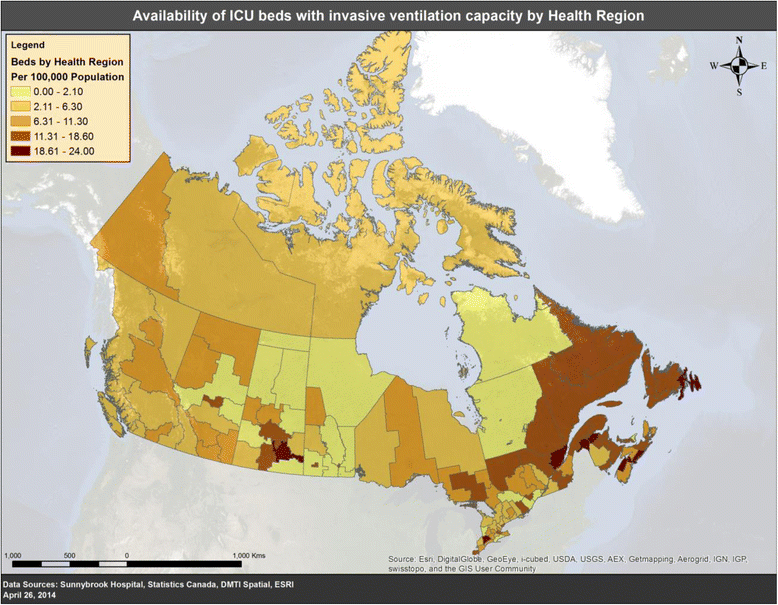Critical care capacity in Canada: results of a national cross-sectional study
- PMID: 25888116
- PMCID: PMC4426537
- DOI: 10.1186/s13054-015-0852-6
Critical care capacity in Canada: results of a national cross-sectional study
Abstract
Introduction: Intensive Care Units (ICUs) provide life-supporting treatment; however, resources are limited, so demand may exceed supply in the event of pandemics, environmental disasters, or in the context of an aging population. We hypothesized that comprehensive national data on ICU resources would permit a better understanding of regional differences in system capacity.
Methods: After the 2009-2010 Influenza A (H1N1) pandemic, the Canadian Critical Care Trials Group surveyed all acute care hospitals in Canada to assess ICU capacity. Using a structured survey tool administered to physicians, respiratory therapists and nurses, we determined the number of ICU beds, ventilators, and the ability to provide specialized support for respiratory failure.
Results: We identified 286 hospitals with 3170 ICU beds and 4982 mechanical ventilators for critically ill patients. Twenty-two hospitals had an ICU that routinely cared for children; 15 had dedicated pediatric ICUs. Per 100,000 population, there was substantial variability in provincial capacity, with a mean of 0.9 hospitals with ICUs (provincial range 0.4-2.8), 10 ICU beds capable of providing mechanical ventilation (provincial range 6-19), and 15 invasive mechanical ventilators (provincial range 10-24). There was only moderate correlation between ventilation capacity and population size (coefficient of determination (R(2)) = 0.771).
Conclusion: ICU resources vary widely across Canadian provinces, and during times of increased demand, may result in geographic differences in the ability to care for critically ill patients. These results highlight the need to evolve inter-jurisdictional resource sharing during periods of substantial increase in demand, and provide background data for the development of appropriate critical care capacity benchmarks.
Figures
References
-
- Shahpori R, Gibney N, Guebert N, Hatcher C, Zygun D. An on-line dashboard to facilitate monitoring of provincial ICU bed occupancy in Alberta. Canada J Hosp Admin. 2014;3:1.
-
- Population projections for Canada, provinces and territories – 2000–2026. Catalogue #91-520. Statistics Canada. p. 110. http://www.statcan.gc.ca/pub/91-520-x/2010001/technote-notetech3-eng.htm. April 6, 2015.
Publication types
MeSH terms
Grants and funding
LinkOut - more resources
Full Text Sources
Other Literature Sources
Medical


